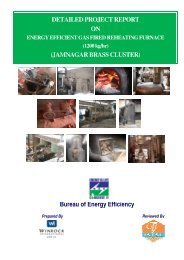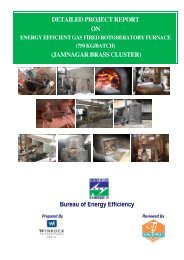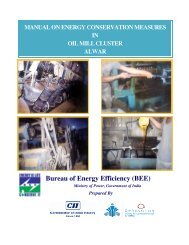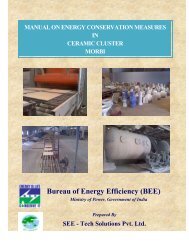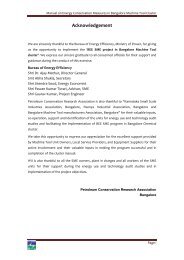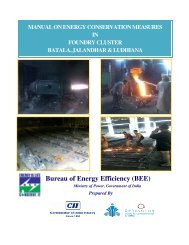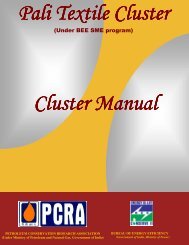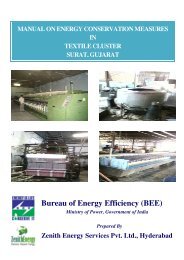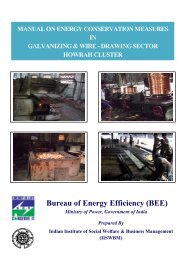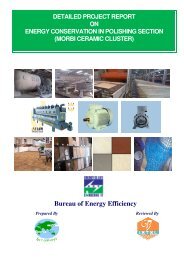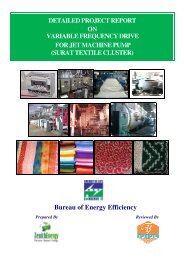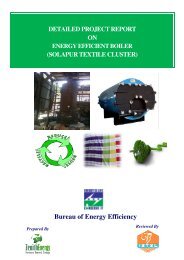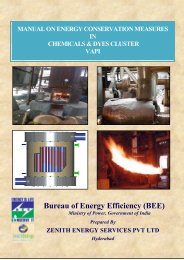DPR on solar water heating system (2000LPD) - Sameeeksha
DPR on solar water heating system (2000LPD) - Sameeeksha
DPR on solar water heating system (2000LPD) - Sameeeksha
You also want an ePaper? Increase the reach of your titles
YUMPU automatically turns print PDFs into web optimized ePapers that Google loves.
Prepared By<br />
DETAILED PROJECT REPORT<br />
ON<br />
SOLAR WATER HEATING SYSTEM<br />
(SOLAPUR TEXTILE CLUSTER)<br />
Bureau of Energy Efficiency<br />
Reviewed By
SOLAR WATER HEATING SYSTEM<br />
SOLAPUR TEXTILE CLUSTER
For more informati<strong>on</strong><br />
BEE, 2010<br />
Bureau of Energy Efficiency (BEE)<br />
(Ministry of Power, Government of India)<br />
4 th Floor, Sewa Bhawan<br />
R. K. Puram, New Delhi – 110066<br />
Detailed Project Report <strong>on</strong> Solar Water Heating System (2000 LPD)<br />
Textile SME Cluster, Pune, Maharashtra (India)<br />
New Delhi: Bureau of Energy Efficiency;<br />
Detail Project Report No.: SLP/TXT/SHW/03<br />
Teleph<strong>on</strong>e +91-11-26179699<br />
Fax +91-11-26178352<br />
Websites: www.bee-india.nic.in<br />
Email: jsood@beenet.in/ pktiwari@beenet.in
Acknowledgement<br />
We sincerely appreciate the efforts of industry, energy auditors, equipment manufacturers,<br />
technology providers, c<strong>on</strong>sultants and other experts in the area of energy c<strong>on</strong>servati<strong>on</strong> for<br />
joining hands with Bureau of Energy Efficiency (BEE), Ministry of Power, Government of India<br />
for preparing the Detailed Project Report (<str<strong>on</strong>g>DPR</str<strong>on</strong>g>) under BEE SME Program in SMEs clusters.<br />
We appreciate the support of suppliers/vendors for providing the adoptable energy efficient<br />
equipments/technical details to the SMEs.<br />
We have received very encouraging feedback for the BEE SME Program in various SME<br />
Clusters. Therefore, it was decided to bring out the <str<strong>on</strong>g>DPR</str<strong>on</strong>g> for the benefits of SMEs. We<br />
sincerely thank the officials of BEE, Executing Agencies and ISTSL for all the support and<br />
cooperati<strong>on</strong> extended for preparati<strong>on</strong> of the <str<strong>on</strong>g>DPR</str<strong>on</strong>g>. We gracefully acknowledge the diligent<br />
efforts and commitments of all those who have c<strong>on</strong>tributed in preparati<strong>on</strong> of the <str<strong>on</strong>g>DPR</str<strong>on</strong>g>.
C<strong>on</strong>tent<br />
List of Annexure…………………………………………………………………………………….….iv<br />
List of Tables…………………………………………………………………………………………...iv<br />
List of Figures…………………………………………………………………………………………..v<br />
List of Abbreviati<strong>on</strong>…………………………………………………………………………………….v<br />
Executive summary……………………………………………………………………………………vi<br />
About BEE’S SME program………………………………………………………………………….vii<br />
1 INTRODUCTION ......................................................................................................... 1<br />
1.1 About the SME cluster ................................................................................................. 1<br />
1.2 Energy performance in Solapur textile cluster .............................................................. 3<br />
1.2.1 Specific energy c<strong>on</strong>sumpti<strong>on</strong> ....................................................................................... 4<br />
1.3 Identificati<strong>on</strong> of technology/equipment ......................................................................... 4<br />
1.3.1 Descripti<strong>on</strong> of technology/equipment to be replaced .................................................... 4<br />
1.3.2 Role in process ............................................................................................................ 6<br />
1.4 Establishing the baseline for the technology/equipment ............................................... 6<br />
1.4.1 Energy audit methodology adopted ............................................................................. 6<br />
1.4.2 Operating efficiency ..................................................................................................... 8<br />
1.5 Barriers in adopti<strong>on</strong> of proposed technology / equipments ........................................... 8<br />
1.5.2 Financial Barrier .......................................................................................................... 9<br />
1.5.3 Manpower skill ............................................................................................................. 9<br />
1.5.4 Other barrier (if any) .................................................................................................... 9<br />
2 TECHNOLOGY/EQUIPMENT FOR ENERGY EFFICIENCY IMPROVEMENTS........ 10<br />
2.1 Solar <strong>water</strong> <strong>heating</strong> <strong>system</strong> (SWHS) ......................................................................... 10<br />
2.1.1 Descripti<strong>on</strong> of technology/equipment ......................................................................... 10<br />
2.1.2 Equipment specificati<strong>on</strong> ............................................................................................. 12<br />
2.1.3 Suitability with existing process.................................................................................. 12<br />
2.1.4 Availability of equipment/technology .......................................................................... 12
2.1.5 Source of equipment supplier ................................................................................... 12<br />
2.1.6 Technical specificati<strong>on</strong>s of equipment........................................................................ 12<br />
2.1.7 Terms and c<strong>on</strong>diti<strong>on</strong>s in sales of SWHS .................................................................... 13<br />
2.1.8 Process down time during Implementati<strong>on</strong> ................................................................ 13<br />
2.2 Life cycle of equipment .............................................................................................. 13<br />
2.3 Suitable unit for Implementati<strong>on</strong> of proposed equipment ........................................... 14<br />
3 ECONOMIC BENEFIT DUE USES OF SWHS .......................................................... 15<br />
3.1 Technical benefit ....................................................................................................... 15<br />
3.1.1 Fuel saving ................................................................................................................ 15<br />
3.1.2 Electricity saving ........................................................................................................ 15<br />
3.1.3 Improvement in product quality .................................................................................. 15<br />
3.1.4 Increase in producti<strong>on</strong> ............................................................................................... 15<br />
3.1.5 Reducti<strong>on</strong> in raw material c<strong>on</strong>sumpti<strong>on</strong> ..................................................................... 15<br />
3.2 M<strong>on</strong>etary benefits ...................................................................................................... 15<br />
3.2 Social benefits .......................................................................................................... 16<br />
3.2.1 Improvement in working envir<strong>on</strong>ment in the plant ...................................................... 16<br />
3.2.2 Improvement in skill set of workers ............................................................................ 16<br />
3.2.3 Impact <strong>on</strong> wages/emoluments ................................................................................... 16<br />
3.3 Envir<strong>on</strong>mental benefits .............................................................................................. 16<br />
3.3.1 Reducti<strong>on</strong> in effluent generati<strong>on</strong> ............................................................................... 16<br />
3.3.2 Reducti<strong>on</strong> in GHG emissi<strong>on</strong> such as CO2, NOx ......................................................... 16<br />
3.3.3 Reducti<strong>on</strong> in other emissi<strong>on</strong>s like SOx ....................................................................... 16<br />
3.3.4 Reducti<strong>on</strong> of deforestati<strong>on</strong> ......................................................................................... 16<br />
4 INSTALLATION OF NEW ENERGY EFFICIENT EQUIPMENT ................................ 17<br />
4.1 Cost of project .......................................................................................................... 17<br />
4.1.1 Cost of equipment...................................................................................................... 17<br />
4.1.2 Other costs ................................................................................................................ 17
4.2 Arrangement of funds ................................................................................................ 17<br />
4.2.1 Entrepreneur’s c<strong>on</strong>tributi<strong>on</strong> ....................................................................................... 17<br />
4.2.2 Loan amount ............................................................................................................. 17<br />
4.2.3 Subsidy by Government............................................................................................. 17<br />
4.2.3 Terms & c<strong>on</strong>diti<strong>on</strong>s of loan ........................................................................................ 18<br />
4.3 Financial indicators .................................................................................................... 18<br />
4.3.1 Cash flow analysis ..................................................................................................... 18<br />
4.3.2 Simple payback period .............................................................................................. 18<br />
4.3.3 Net Present Value (NPV) ........................................................................................... 18<br />
4.3.4 Internal rate of return (IRR) ........................................................................................ 18<br />
4.3.5 Return <strong>on</strong> investment (ROI) ....................................................................................... 18<br />
4.4 Sensitivity analysis ..................................................................................................... 19<br />
4.5 Procurement and implementati<strong>on</strong> schedule ................................................................ 19
List of Annexure<br />
Annexure – 1 Efficiency of the existing chulhas - Direct Method ............................................ 20<br />
Annexure – 2 Process flow diagrams .................................................................................... 22<br />
Annexure - 3 Detailed technology assessment report............................................................ 23<br />
Annexure – 4 Drawings for proposed electrical & civil works ................................................ 24<br />
Annexure- 5 Detailed financial calculati<strong>on</strong>s & analysis for financial indicators ....................... 25<br />
Annexure -6 Details of procurement and implementati<strong>on</strong> plan with schedule/timelines ......... 30<br />
Annexure -7 Details of equipment service providers .............................................................. 31<br />
Annexure - 8 Quotati<strong>on</strong>s or Techno-commercial bids for new technology/ equipment ........... 32<br />
List of Table<br />
Table 1.1Energy c<strong>on</strong>sumpti<strong>on</strong> of a typical unit ........................................................................ 1<br />
Table 1.2 Specific energy c<strong>on</strong>sumpti<strong>on</strong> of typical units ............................................................ 4<br />
Table 1.3 Operating efficiency of three different units .............................................................. 8<br />
Table 2.1 Comparis<strong>on</strong> of chulhas with SWHS ....................................................................... 11<br />
Table 2.2: Technical specificati<strong>on</strong>s ........................................................................................ 12<br />
Table 2.3 Terms & c<strong>on</strong>diti<strong>on</strong>s of sale for energy efficient boiler ............................................. 13<br />
Table 3.1: Energy and cost benefit analysis of energy efficient boiler .................................... 15<br />
Table 4.1: Details of project cost .......................................................................................... 17<br />
Table 4.2: Financial indicator of project ................................................................................ 18<br />
Table 4.3: Sensitivity analysis in different scenario ............................................................... 19<br />
iv
List of Figures<br />
Figure 1.1 Process flow chart of typical textile unit ................................................................... 3<br />
Figure 1.2 C<strong>on</strong>venti<strong>on</strong>al chulhas operati<strong>on</strong>s at typical textile industry ..................................... 5<br />
List of Abbreviati<strong>on</strong><br />
BEE Bureau of Energy Efficiency<br />
<str<strong>on</strong>g>DPR</str<strong>on</strong>g> Detailed Project Report<br />
DSCR Debt Service Coverage Ratio<br />
FD Forced Draft<br />
GHG Green House Gases<br />
HP Horse Power<br />
IBR Indian Boiler Regulati<strong>on</strong><br />
IRR Internal Rate of Return<br />
ID Induced Draft<br />
NPV Net Present Value<br />
ROI Return <strong>on</strong> Investment<br />
SME Small and Medium Enterprises<br />
SIDBI Small Industries Development Bank of India<br />
v
EXECUTIVE SUMMARY<br />
Zenith Energy Services Pvt. Ltd is executing BEE - SME program in Solapur textile cluster,<br />
supported by Bureau of Energy Efficiency with an overall objective of improving the energy<br />
efficiency in cluster units.<br />
Since Solapur cluster is <strong>on</strong>e of the largest clusters in textile sector in India, accordingly this<br />
cluster was chosen for energy efficiency improvements by implementing energy efficient<br />
technologies, so as to facilitate maximum replicati<strong>on</strong> in other textile clusters in India. Solapur<br />
textile cluster is mainly famous for cott<strong>on</strong> towel and bed sheet products. The main form of<br />
energy used in the cluster units are grid electricity, wood, and small quantity of coal. Wood<br />
and coal are used in boiler for generating hot <strong>water</strong> which is further used in dyeing of yarn.<br />
This <str<strong>on</strong>g>DPR</str<strong>on</strong>g> highlighted the energy, envir<strong>on</strong>ment, ec<strong>on</strong>omic and social benefits by replacing less<br />
efficient existing technology i.e. c<strong>on</strong>venti<strong>on</strong>al chulhas with 2000 LPD <strong>solar</strong> <strong>water</strong> <strong>heating</strong><br />
<strong>system</strong> (SWHS).<br />
The project activities reduce overall wood c<strong>on</strong>sumpti<strong>on</strong> by 42 t<strong>on</strong>nes per year and there is no<br />
saving in electricity c<strong>on</strong>sumpti<strong>on</strong>.<br />
Project cost, debt equity ratio, m<strong>on</strong>etary benefit, simple payback period, internal rate of return,<br />
net present value, dept service coverage ratio etc for proposed <strong>solar</strong> <strong>water</strong> <strong>heating</strong> <strong>system</strong> are<br />
furnished in table below:<br />
S.No Parameter Unit Value<br />
1 Project cost ` in lakh 3.47<br />
2 Debit equity ratio Ratio 3:1<br />
3 M<strong>on</strong>etary benefit ` in lakh 1.26<br />
4 Simple payback period Years 2.75<br />
5 Net present value in 3 years @ 10.00% ` in lakh 0.43<br />
6 Internal rate of return % 14.51<br />
7 Return <strong>on</strong> Investment % 27.21<br />
8 Average debt service coverage ratio Ratio 1.50<br />
9 Procurement and implementati<strong>on</strong> schedules Week 8-10<br />
The projected profitability and financial indicators shows that the project will be able to earn<br />
profit from incepti<strong>on</strong> and replacement of c<strong>on</strong>venti<strong>on</strong>al chulhas with SWHS project is financially<br />
viable and technically feasible.<br />
vi
ABOUT BEE SME PROGRAMME<br />
Bureau of Energy Efficiency (BEE) is implementing a BEE-SME Programme to improve the<br />
energy performance in 25 selected SMEs clusters. Solapur Textile Cluster is <strong>on</strong>e of them.<br />
The BEE’s SME Programme intends to enhance the energy efficiency awareness by<br />
funding/subsidizing need based studies in SME clusters and giving energy c<strong>on</strong>servati<strong>on</strong><br />
recommendati<strong>on</strong>s. For addressing the specific problems of these SMEs and enhancing<br />
energy efficiency in the clusters, BEE will be focusing <strong>on</strong> energy efficiency, energy<br />
c<strong>on</strong>servati<strong>on</strong> and technology upgradati<strong>on</strong> through studies and pilot projects in these SMEs<br />
clusters.<br />
Major activities in the BEE -SME program are furnished below:<br />
Energy use and technology studies<br />
The energy use technology studies would provide informati<strong>on</strong> <strong>on</strong> technology status, best<br />
operating practices, gaps in skills and knowledge <strong>on</strong> energy c<strong>on</strong>servati<strong>on</strong> opportunities,<br />
energy saving potential and new energy efficient technologies, etc for each of the sub sector<br />
in SMEs.<br />
Capacity building of stakeholders in cluster <strong>on</strong> energy efficiency<br />
In most of the cases SME entrepreneurs are dependent <strong>on</strong> the locally available technologies,<br />
service providers for various reas<strong>on</strong>s. To address this issue BEE has also undertaken<br />
capacity building of local service providers and entrepreneurs/ Managers of SMEs <strong>on</strong> energy<br />
efficiency improvement in their units as well as clusters. The local service providers will be<br />
trained in order to be able to provide the local services in setting of energy efficiency projects<br />
in the clusters<br />
Implementati<strong>on</strong> of energy efficiency measures<br />
To implement the technology up gradati<strong>on</strong> projects in clusters, BEE has proposed to prepare<br />
the technology based detailed project reports (<str<strong>on</strong>g>DPR</str<strong>on</strong>g>s) for a minimum of five technologies in<br />
three capacities for each technology.<br />
Facilitati<strong>on</strong> of innovative financing mechanisms for implementati<strong>on</strong> of energy<br />
efficiency projects<br />
The objective of this activity is to facilitate the uptake of energy efficiency measures through<br />
innovative financing mechanisms without creating market distorti<strong>on</strong>.<br />
vii
1 INTRODUCTION<br />
1.1 About the SME cluster<br />
Solar Water Heating System (2000 LPD)<br />
The products manufactured in Solapur Textile Cluster are cott<strong>on</strong> terry towels and bed sheets.<br />
The towels and bed sheets manufactured in the Solapur cluster are renowned in the country<br />
and have good market in India. The main raw material for the units is cott<strong>on</strong> yarn, which is<br />
procured from local spinning mils and agents. The cost of energy (electrical and thermal<br />
energy) as percentage of manufacturing cost varies between 8 and 10%.<br />
Majority of the cluster units are of integrated type, where the raw material yarn is processed<br />
in-house to the final product. The energy cost is sec<strong>on</strong>d to the raw materials cost. Majority of<br />
the units in the cluster are dependent <strong>on</strong> local / run of the mill technologies of low end and<br />
with little investment initiatives and technology up-gradati<strong>on</strong>.<br />
The main energy forms used in the cluster units are grid electricity, wood, and small quantity<br />
of coal. The electricity is used in power looms, doubling machines, winding machines, hydro<br />
extractors, warping machines and lighting. Wood is used as fuel for thermic fluid heaters,<br />
boilers and chulhas for hot <strong>water</strong> generati<strong>on</strong>. The details of annual energy c<strong>on</strong>sumpti<strong>on</strong> of a<br />
typical unit having a producti<strong>on</strong> capacity of approximately 86,400 kg are furnished in the<br />
Table 1.1below:<br />
Table 1.1Energy c<strong>on</strong>sumpti<strong>on</strong> of a typical unit<br />
S.No Particular Unit Value<br />
1 Electricity c<strong>on</strong>sumpti<strong>on</strong> kWh 1,03,500<br />
2 Wood c<strong>on</strong>sumpti<strong>on</strong> t<strong>on</strong>nes 42<br />
3 Producti<strong>on</strong> kg 86,400<br />
Producti<strong>on</strong> processg<br />
The main operati<strong>on</strong>al process for producti<strong>on</strong> of towels and bed sheets in cluster units are:<br />
Doubling<br />
In the Doubling process, thin single yarn is c<strong>on</strong>verted to double yarn for strengthening the<br />
yarn by using doubling machine.<br />
Yarn dyeing<br />
Initially, the yarn is soaked in soap <strong>water</strong> for 24 hours to remove the dirt and other foreign<br />
*Details of Mayuri Textiles, Solapur<br />
1
Solar Water Heating System (2000 LPD)<br />
materials and thereafter yarn is taken for bleaching. Bleaching is carried out by soaking the<br />
yarn in tanks mixed with bleaching agents and after completi<strong>on</strong> of the process; the yarn is<br />
washed with normal <strong>water</strong>.<br />
The hank dyeing machine tanks are filled with required quantity of normal <strong>water</strong> and required<br />
chemicals and dyeing agents are added. The temperature of the <strong>water</strong> is raised by oil<br />
circulati<strong>on</strong> or direct steam injecti<strong>on</strong>. Fire wood is used as fuel. The required colors are added<br />
to the yarn and the dyeing process takes about 90 to 120 minutes per batch. After dyeing, the<br />
yarn is washed with normal <strong>water</strong>, and the yarn is taken for soaping for colour fixati<strong>on</strong> in hot<br />
<strong>water</strong> for about 20 minutes in hank dyeing machines. The <strong>water</strong> is drained to the waste<br />
drainage lines.<br />
Drying<br />
The wet yarn is taken to hydro extractors for removing the <strong>water</strong> in the yarn and taken for<br />
natural drying in the sunlight.<br />
Winding<br />
The yarn after drying is taken for winding in which the yarn is wounded to bobbins and c<strong>on</strong>es.<br />
The winded yarn is taken for further process.<br />
Warping<br />
In warping, the winded yarn is wound to beams according to designed pattern (customized<br />
designs). Then the beams are taken for Weaving.<br />
Weaving<br />
The beams, which are wound with yarn are taken and placed in power looms where the<br />
designed pattern is already set. In power looms, the yarn is c<strong>on</strong>verted to final product (towel<br />
or bed sheets) by weaving machine. The product obtained from weaving is taken for stitching<br />
and packing. The general process flow diagram of a typical unit for producti<strong>on</strong> of towels and<br />
bed sheets is furnished in Figure 1.1 below.<br />
2
Yarn (Raw material)<br />
Doubling (Double yarn)<br />
Reeling<br />
Dyeing<br />
Drying<br />
Winding<br />
Warping<br />
Looms<br />
Stitching & packing<br />
Figure 1.1 Process flow chart of typical textile unit<br />
Solar Water Heating System (2000 LPD)<br />
The producti<strong>on</strong> process as depicted above is similar for all textile units in Solapur textile<br />
cluster. However, depending <strong>on</strong> type of product and product quality, the above stated process<br />
flow varies as per the requirement.<br />
1.2 Energy performance in Solapur textile cluster<br />
Electrical Energy<br />
Electrical Energy<br />
Energy c<strong>on</strong>suming process<br />
Natural (or) Electrical Energy<br />
Electrical Energy<br />
Electrical Energy<br />
Electrical Energy<br />
Thermal Energy<br />
Electrical Energy<br />
The main energy sources for Solapur cluster units are electricity and fuels such as Wood &<br />
GN Husk briquettes. The wood and GN husk briquettes are used as fuel for thermic fluid<br />
3
Solar Water Heating System (2000 LPD)<br />
heaters, boilers and chulhas for hot <strong>water</strong> generati<strong>on</strong> and electricity is used for operati<strong>on</strong> of<br />
prime movers of doubling machine motors, ID fans, pumps, hank dyeing machine drives,<br />
power loom drives, winding machine motors, etc. Majority of the units in the Solapur textile<br />
cluster are using wood for thermal energy generati<strong>on</strong> due to their easy availability and cost<br />
competitiveness.<br />
Energy cost is around 8 to 10 percent of manufacturing cost in typical manufacturing unit, out<br />
of which the cost of thermal energy works out to 42 percent of the total energy cost and<br />
remaining accounts for electrical energy.<br />
In a typical textile manufacturing unit of the cluster, the annual electricity and wood<br />
c<strong>on</strong>sumpti<strong>on</strong> is 1, 03,500 kWh and 42 t<strong>on</strong>nes respectively. Average producti<strong>on</strong> capacity of<br />
typical textile manufacturing unit is around 86,400 kg per annum.<br />
1.2.1 Specific energy c<strong>on</strong>sumpti<strong>on</strong><br />
Specific electrical and thermal energy c<strong>on</strong>sumpti<strong>on</strong> in textile units depends <strong>on</strong> the final<br />
product manufactured in that unit.<br />
The average specific fuel c<strong>on</strong>sumpti<strong>on</strong> per kg of the yarn (dyeing process <strong>on</strong>ly) for 3 typical<br />
units having chulhas for hot <strong>water</strong> generati<strong>on</strong> is furnished below in Table 1.2.<br />
Table 1.2 Specific energy c<strong>on</strong>sumpti<strong>on</strong> of typical units<br />
S.No. Name of unit<br />
1 Yemul Textiles<br />
2 SRL Towel Industry<br />
3 Burgul Textiles<br />
1.3 Identificati<strong>on</strong> of technology/equipment<br />
1.3.1 Descripti<strong>on</strong> of technology/equipment to be replaced<br />
During energy use and technology audit studies in various textile industries in Solapur textile<br />
cluster, it has been observed that about 250 to 300 c<strong>on</strong>venti<strong>on</strong>al chulhas having poor energy<br />
efficiency are being used in entire cluster. The performance of various existing chulhas are<br />
evaluated and furnished in Annexure 1.<br />
Specific fuel c<strong>on</strong>sumpti<strong>on</strong><br />
kg of wood/kg of yarn<br />
0.48<br />
0.44<br />
0.37<br />
4
Solar Water Heating System (2000 LPD)<br />
Figure 1.2 C<strong>on</strong>venti<strong>on</strong>al chulhas operati<strong>on</strong>s at typical textile industry<br />
From energy use and technology gap audit studies in various textile industries in Solapur<br />
textile cluster, the following were identified:<br />
• Energy efficiency improvement opportunities<br />
• Envir<strong>on</strong>ment and working c<strong>on</strong>diti<strong>on</strong>s improvement<br />
• Design flaws in the c<strong>on</strong>venti<strong>on</strong>al chulhas<br />
Technical gap analysis in wood fired boiler<br />
The following technology gaps in wood fired inefficient chulhas are identified in a typical unit:<br />
• The c<strong>on</strong>venti<strong>on</strong>al local chulha has no mechanism for air circulati<strong>on</strong> and smoke<br />
removal<br />
• Heat losses through the grate openings from the fr<strong>on</strong>t and back end sides<br />
• No c<strong>on</strong>trol <strong>on</strong> air supply for combusti<strong>on</strong><br />
• Radiati<strong>on</strong> losses from all sides of the chulha<br />
• Lack of m<strong>on</strong>itoring of wood feeding<br />
From the above menti<strong>on</strong>ed analysis it is clear that the performance of the existing<br />
c<strong>on</strong>venti<strong>on</strong>al chulhas is poor in terms of energy, envir<strong>on</strong>ment and social aspects. Based <strong>on</strong><br />
above facts, the present inefficient chulhas is to be replaced with <strong>solar</strong> hot <strong>water</strong> <strong>system</strong><br />
(SHWS).<br />
5
1.3.2 Role in process<br />
Solar Water Heating System (2000 LPD)<br />
For producti<strong>on</strong> of towels and bed sheets of different colours, the dyeing of cott<strong>on</strong> yarn is vital<br />
and dyeing process requires hot <strong>water</strong>. The chulhas is used for hot <strong>water</strong> generati<strong>on</strong> and also<br />
to maintain the c<strong>on</strong>stant temperature during the dyeing and soaping process.<br />
1.4 Establishing the baseline for the technology/equipment<br />
Energy c<strong>on</strong>sumpti<strong>on</strong> in chulhas would depend <strong>on</strong> the followings:<br />
• Cold <strong>water</strong> temperature<br />
• Dyeing temperature which depends <strong>on</strong> the color of the yarn<br />
• Quantity of hot <strong>water</strong> required<br />
• Climate c<strong>on</strong>diti<strong>on</strong>s<br />
• Type of wood and its calorific value<br />
Energy use and technology audit studies were c<strong>on</strong>ducted in various units of Solapur textile<br />
cluster, the baseline energy c<strong>on</strong>sumpti<strong>on</strong> of present inefficient chulhas and their performance<br />
data is attached in Annexure 1.<br />
1.4.1 Energy audit methodology adopted<br />
The following methodology was adopted to evaluate the performance of boilers:<br />
6
Regular m<strong>on</strong>itoring of operating<br />
parameters including flue gas<br />
analysis<br />
M<strong>on</strong>itoring of wood c<strong>on</strong>sumpti<strong>on</strong> for a<br />
specific period of time<br />
M<strong>on</strong>itoring of quantity of hot <strong>water</strong><br />
generated<br />
Initial and Final temperatures of hot<br />
<strong>water</strong> in Chulhas<br />
Collecti<strong>on</strong> of all standard data including<br />
technical details of equipment and energy<br />
c<strong>on</strong>sumpti<strong>on</strong><br />
Compiling the measurements and the<br />
data and calculati<strong>on</strong> of efficiency by direct<br />
method<br />
Performance evaluati<strong>on</strong> of the <strong>system</strong>s<br />
Solar Water Heating System (2000 LPD)<br />
Regular m<strong>on</strong>itoring of fuel<br />
c<strong>on</strong>sumpti<strong>on</strong><br />
rate<br />
7
1.4.2 Operating efficiency<br />
Solar Water Heating System (2000 LPD)<br />
The operating efficiency of the chulhas installed in various units of the cluster used for hot<br />
<strong>water</strong> generati<strong>on</strong> for 3 units is furnished in Table 1.3 below and also details of efficiency<br />
calculati<strong>on</strong> are shown in Annexure 1.<br />
Table 1.3 Operating efficiency of three different units<br />
S.No Name of the unit Unit Value<br />
1 Yemul Textiles %age 6.25<br />
2 Burgul Textiles %age 5.04<br />
3 Chatla Textiles %age 6.2<br />
1.5 Barriers in adopti<strong>on</strong> of proposed technology / equipments<br />
Major barriers in the upgradati<strong>on</strong> of technology in the cluster are<br />
• N<strong>on</strong> availability of desired technology in the local market<br />
• Distrust <strong>on</strong> technology supplier<br />
• Lack of informati<strong>on</strong> about energy efficiency<br />
The other barriers identified for implementati<strong>on</strong> of energy efficiency in Solapur textile cluster<br />
are as under:<br />
1.5.1 Technological Barrier<br />
The major technical barriers that prevented the implementati<strong>on</strong> of SWHS in typical unit:<br />
• Lack of awareness and informati<strong>on</strong> about the new and emerging technologies<br />
available in the market.<br />
• A lack of awareness about the favorable lifecycle ec<strong>on</strong>omics of SWHS technology vis<br />
à vis present <strong>system</strong> of hot <strong>water</strong> generati<strong>on</strong><br />
• Dependence <strong>on</strong> local equipment suppliers for uninterrupted after sales service<br />
• The lack of technical know-how made it impossible for the textile unit owners to<br />
identify the most effective technical measures.<br />
• The availability of <strong>solar</strong> radiati<strong>on</strong> is intermittent in nature and hence, the producti<strong>on</strong><br />
process may disrupt and need to depend <strong>on</strong> auxiliary <strong>heating</strong> <strong>system</strong>, which requires<br />
additi<strong>on</strong>al investment and maintenance of the equipments.<br />
8
1.5.2 Financial Barrier<br />
Solar Water Heating System (2000 LPD)<br />
The Financial barriers for adopti<strong>on</strong> of SWHS are most comm<strong>on</strong>. Some major financial barriers<br />
which prevent the implementati<strong>on</strong> of proposed technology are:<br />
• Implementati<strong>on</strong> of the proposed project activity requires investment of ` 3.47 lakh,<br />
which is a significant investment and not comm<strong>on</strong>ly seen in the cluster for energy<br />
efficiency.<br />
• Low cost of c<strong>on</strong>venti<strong>on</strong>al fuel is the main reas<strong>on</strong> for low demand or low penetrati<strong>on</strong> of<br />
SWHS technology. Further, the high initial cost of the <strong>solar</strong> hot <strong>water</strong> <strong>system</strong> due to<br />
dependence <strong>on</strong> expensive imported <strong>system</strong>s makes the SWH technology costly<br />
leading to reluctance in its adopti<strong>on</strong> by cluster units.<br />
• Relative high investment and comparative low returns is also <strong>on</strong>e of the major<br />
financial barriers for the adopti<strong>on</strong> of SWHS.<br />
• The majority of the unit owners are of the view that it makes business sense for them<br />
to invest in enhancing producti<strong>on</strong> capacity rather than making investment in energy<br />
efficiency.<br />
• The unit owners in the cluster are wary of approaching banks for financial assistance<br />
due to their old percepti<strong>on</strong> that getting loan sancti<strong>on</strong>ed from Banks involves lot of<br />
paper work / documentati<strong>on</strong> and needs collateral security. .<br />
However, the financial attractiveness of the project activity and the other benefits such as<br />
subsidy & depreciati<strong>on</strong> for the equipments may motivate the unit owners to move forward in<br />
adopting SWHS.<br />
1.5.3 Manpower skill<br />
Skilled manpower is not required for adopti<strong>on</strong> / operati<strong>on</strong> of SWHS.<br />
1.5.4 Other barrier (if any)<br />
Some of the SME unit owners are willing to adopt SWHS technology however they often<br />
encounter difficulty in finding credible local suppliers of SWHS who can provide <strong>system</strong><br />
design and further assist them in installati<strong>on</strong> and maintenance of SWHS.<br />
9
Solar Water Heating System (2000 LPD)<br />
2 TECHNOLOGY/EQUIPMENT FOR ENERGY EFFICIENCY IMPROVEMENTS<br />
2.1 Solar <strong>water</strong> <strong>heating</strong> <strong>system</strong> (SWHS)<br />
2.1.1 Descripti<strong>on</strong> of technology/equipment<br />
The Solar Hot Water Systems c<strong>on</strong>sists of two main parts:<br />
• Solar collector<br />
• Storage tank<br />
The collector used in such SWHS is of flat-plate type. The <strong>solar</strong> radiati<strong>on</strong> directly falls <strong>on</strong> the<br />
collector surface and the <strong>solar</strong> energy is c<strong>on</strong>verted into thermal energy. Water is circulated in<br />
tube and gets heated by <strong>solar</strong> energy. Heated <strong>water</strong> is then stored in the storage tank for use<br />
in the process. However, the existing c<strong>on</strong>venti<strong>on</strong>al <strong>system</strong> is sometimes also maintained to<br />
provide the thermal heat required during inclement weather c<strong>on</strong>diti<strong>on</strong>s.<br />
Figure 2.1: Solar hot <strong>water</strong> <strong>system</strong><br />
Solar <strong>water</strong> <strong>heating</strong> <strong>system</strong>s can be either active or passive. However, the present <str<strong>on</strong>g>DPR</str<strong>on</strong>g> is<br />
prepared for passive <strong>solar</strong> <strong>water</strong> <strong>system</strong> which is most comm<strong>on</strong>ly used.<br />
Passive <strong>solar</strong> <strong>water</strong> heaters<br />
Passive <strong>solar</strong> <strong>water</strong> <strong>heating</strong> <strong>system</strong> works <strong>on</strong> Thermosyph<strong>on</strong> principal. Such <strong>system</strong>s are<br />
ec<strong>on</strong>omical and reliable choice. These <strong>system</strong>s rely <strong>on</strong> the natural c<strong>on</strong>vecti<strong>on</strong> of <strong>water</strong>. As<br />
<strong>water</strong> in the <strong>solar</strong> collector heats, it becomes lighter and rises naturally into the storage tank<br />
above. Meanwhile, the cooler <strong>water</strong> flows down the pipes to the bottom of the collector,<br />
enhancing the circulati<strong>on</strong>.<br />
10
Solar collectors<br />
Solar Water Heating System (2000 LPD)<br />
Solar collectors are the key comp<strong>on</strong>ent of SWHS. Solar collectors gather the sun's energy,<br />
transform its radiati<strong>on</strong> into heat, and then transfer that heat to <strong>water</strong>. There are several types<br />
of <strong>solar</strong> collectors viz flat-plate collector, evacuated-tube collector and integer collector-<br />
storage <strong>system</strong>. However, Flat –plate collectors are generally used.<br />
Flat-plate collectors<br />
Flat-plate collectors are the most comm<strong>on</strong> <strong>solar</strong> collector for SWHS. A typical flat-plate<br />
collector is an insulated metal box with a glass or plastic cover (called the glazing) and a dark-<br />
colored absorber plate. These Collectors, heat liquid or air at temperatures less than 80°C.<br />
Liquid flat-plate collector’s heat liquid as it flows through tubes in or adjacent to the absorber<br />
plate. The simplest liquid <strong>system</strong>s use potable <strong>water</strong>, which is heated as it passes directly<br />
through the collector and then flows to the process line.<br />
Comparis<strong>on</strong> of c<strong>on</strong>venti<strong>on</strong>al chulhas with SWHS is shown in Table 2.1below:<br />
Table 2.1 Comparis<strong>on</strong> of chulhas with SWHS<br />
S. No Details Chulhas SWHS<br />
1 Wood c<strong>on</strong>sumpti<strong>on</strong> High No fuel required<br />
2 Envir<strong>on</strong>ment polluti<strong>on</strong> High Polluti<strong>on</strong> free<br />
3 Safety of workers Poor Good<br />
4 Maintenance High Low (<strong>on</strong>ly cleaning of collector surface)<br />
5 Operati<strong>on</strong>al cost High Nill<br />
6<br />
Availability of local service<br />
providers<br />
Yes Yes / limited<br />
7 Hot <strong>water</strong> generati<strong>on</strong> C<strong>on</strong>tinuous Intermittent<br />
8 Fuel cost High Nill<br />
9 Man power Required No required<br />
10 GHG emissi<strong>on</strong> High No GHG emissi<strong>on</strong><br />
Though, the availability of hot <strong>water</strong> is intermittent and requirement of hot <strong>water</strong> is partially<br />
met, the other benefits of <strong>solar</strong> hot <strong>water</strong> <strong>system</strong>s such as relatively nil operati<strong>on</strong>al and<br />
maintenance cost, clean and free form of energy and other ec<strong>on</strong>omic benefits such as<br />
11
Solar Water Heating System (2000 LPD)<br />
availability of capital subsidy and accelerated depreciati<strong>on</strong> etc makes it attractive propositi<strong>on</strong><br />
for the cluster units to install <strong>solar</strong> hot <strong>water</strong> <strong>system</strong>.<br />
2.1.2 Equipment specificati<strong>on</strong><br />
Equipment specificati<strong>on</strong> of SWHS al<strong>on</strong>g with terms of sales, performance guarantee and after<br />
sales services details are furnished in Annexure 8.<br />
2.1.3 Suitability with existing process<br />
The proposed new equipment is used for hot <strong>water</strong> generati<strong>on</strong> which was earlier generated<br />
by c<strong>on</strong>venti<strong>on</strong>al chulhas. Hence proposed equipment is suitable with existing process.<br />
2.1.4 Availability of equipment / technology<br />
Based <strong>on</strong> the detailed energy use and technology audits c<strong>on</strong>ducted in various textile<br />
industries in Solapur textile cluster, it is suggested to install <strong>solar</strong> hot <strong>water</strong> <strong>system</strong> of 2000<br />
LPD capacity for dyeing and soaping process.<br />
The company representatives of various <strong>solar</strong> equipment suppliers are locally available in<br />
Solapur and these companies will also provide necessary guidance for documentati<strong>on</strong><br />
required for getting loan and financial incentives available for installing SWHS.<br />
The technology provider identified has successfully implemented SWHS in few units of the<br />
cluster.<br />
2.1.5 Source of equipment supplier<br />
The technology/service provider “M/s TATA BP Solar India Ltd” is <strong>on</strong>e of the leading<br />
companies in India engaged in the manufacture and supply of SWHS and having experience<br />
of more than 3 decades. Details of other service providers are given in Annexure 7.<br />
2.1.6 Technical specificati<strong>on</strong>s of equipment<br />
Technical and design specificati<strong>on</strong>s of proposed SWHS are given in Table 2.2 below:<br />
Table 2.2: Technical specificati<strong>on</strong>s<br />
Details Units Value<br />
Name of equipment NA Solar <strong>water</strong> <strong>heating</strong> <strong>system</strong><br />
Model NA VIJRA<br />
Capacity LPD 1000<br />
Temperature of hot <strong>water</strong> o C 60<br />
Ambient temperature o C 25<br />
12
Solar Water Heating System (2000 LPD)<br />
VAJRA 1000 LPD N<strong>on</strong>-Press, N<strong>on</strong>- HHC, Thermosyph<strong>on</strong> type Solar Water Heating <strong>system</strong> @<br />
60 deg. C c<strong>on</strong>sisting of:<br />
• 1 nos. x 1000 lit. insulated SS304 hot <strong>water</strong> storage tanks,<br />
• 8 nos. of TBP make <strong>solar</strong> flat plate collectors,<br />
• Mounting stand for tanks & collectors,<br />
Detail technical specificati<strong>on</strong>s of SWHS are shown in Annexure 7.<br />
2.1.7 Terms and c<strong>on</strong>diti<strong>on</strong>s in sales of SWHS<br />
The terms and c<strong>on</strong>diti<strong>on</strong>s of the company for supply of <strong>solar</strong> hot <strong>water</strong> <strong>system</strong> are shown in<br />
Table 2.3 below:<br />
Table 2.3 Terms & c<strong>on</strong>diti<strong>on</strong>s of sale for energy efficient boiler<br />
2.1.8 Process down time during Implementati<strong>on</strong><br />
There is no process down time, as the proposed equipment is additi<strong>on</strong>al equipment.<br />
2.2 Life cycle of equipment<br />
The life expectancy of SWHS is 8-12 year depending up<strong>on</strong> its maintenance, cleaning and<br />
uses.<br />
Details Units Value<br />
Transmitivity %age 85<br />
Particular C<strong>on</strong>diti<strong>on</strong><br />
Price Transportati<strong>on</strong>, Loading - Unloading & Handling Charges at actual<br />
Insurance 0.45%<br />
Taxes CST 4% and exempted from excise duty<br />
Delivery 7 weeks from the date of order with advance<br />
Inspecti<strong>on</strong> Inspecti<strong>on</strong> of equipment prior dispatch, at your own cost<br />
Commissi<strong>on</strong>ing Included in total cost<br />
Inspecti<strong>on</strong> At our works prior to dispatch<br />
Guarantee 18 m<strong>on</strong>ths from the date of Performa invoice or 12 m<strong>on</strong>ths from the date of<br />
completi<strong>on</strong> of installati<strong>on</strong>, which ever is less<br />
13
2.3 Suitable unit for Implementati<strong>on</strong> of proposed equipment<br />
Solar Water Heating System (2000 LPD)<br />
Large quantities of hot <strong>water</strong> is required in the dyeing process and the proposed <strong>system</strong> will<br />
give an output of 2000 LPD, which replaces about 2000 LPD hot <strong>water</strong> generati<strong>on</strong> in<br />
c<strong>on</strong>venti<strong>on</strong>al chulha <strong>system</strong>s .<br />
14
3 ECONOMIC BENEFIT DUE USES OF SWHS<br />
3.1 Technical benefit<br />
3.1.1 Fuel saving<br />
Solar Water Heating System (2000 LPD)<br />
The wood savings due to installati<strong>on</strong> of SWHS in a typical unit having 2000 LPD hot <strong>water</strong><br />
generati<strong>on</strong> capacity is estimated as 42 t<strong>on</strong>nes per annum. The wood savings is estimated<br />
based <strong>on</strong> the present Chulhas efficiency of 5.04 %<br />
3.1.2 Electricity saving<br />
Project implementati<strong>on</strong> will not save electricity c<strong>on</strong>sumpti<strong>on</strong>.<br />
3.1.3 Improvement in product quality<br />
Product quality achieved would be same as the present quality. It does not have any impact in<br />
improving the quality of the product.<br />
3.1.4 Increase in producti<strong>on</strong><br />
The proposed equipment does not c<strong>on</strong>tribute to any increase in producti<strong>on</strong>.<br />
3.1.5 Reducti<strong>on</strong> in raw material c<strong>on</strong>sumpti<strong>on</strong><br />
Raw material c<strong>on</strong>sumpti<strong>on</strong> is same even after the implementati<strong>on</strong> of proposed technology.<br />
3.2 M<strong>on</strong>etary benefits<br />
Annual m<strong>on</strong>etary savings due to implementati<strong>on</strong> of SWHS in place of the c<strong>on</strong>venti<strong>on</strong>al<br />
chulhas is ` 1.26 lakh per annum. Energy & m<strong>on</strong>etary benefit analysis of energy efficient<br />
boiler is presented in Table 3.1 below:<br />
Table 3.1: Energy and cost benefit analysis of energy efficient boiler<br />
S.No Parameter Unit Value<br />
1 Wood c<strong>on</strong>sumpti<strong>on</strong> in existing chulhas T<strong>on</strong>nes/annum 42<br />
2 Operati<strong>on</strong>al hours hours 8<br />
3 Operati<strong>on</strong>al days per annum Days 240<br />
4 Wood c<strong>on</strong>sumpti<strong>on</strong> in proposed equipment T<strong>on</strong>nes/annum Nill<br />
5 Wood saving T<strong>on</strong>nes/annum 42<br />
6 Cost of wood `/T<strong>on</strong>ne 3000<br />
7 Total m<strong>on</strong>etary benefit ` in lakh 1.26<br />
15
3.2 Social benefits<br />
3.2.1 Improvement in working envir<strong>on</strong>ment in the plant<br />
Solar Water Heating System (2000 LPD)<br />
The replacement of inefficient chulhas with SWHS will reduce the wood c<strong>on</strong>sumpti<strong>on</strong> and will<br />
improve the work c<strong>on</strong>diti<strong>on</strong> and envir<strong>on</strong>ment.<br />
3.2.2 Improvement in skill set of workers<br />
The technology implemented will create awareness am<strong>on</strong>g the workforce towards clean and<br />
renewable energy <strong>system</strong>s.<br />
3.2.3 Impact <strong>on</strong> wages/emoluments<br />
No significant impact <strong>on</strong> wages and emoluments of the workers.<br />
3.3 Envir<strong>on</strong>mental benefits<br />
3.3.1 Reducti<strong>on</strong> in effluent generati<strong>on</strong><br />
There is no major impact in effluent generati<strong>on</strong> due to implementati<strong>on</strong> of the project<br />
3.3.2 Reducti<strong>on</strong> in GHG emissi<strong>on</strong> such as CO2, NOx<br />
Implementati<strong>on</strong> of this project will lead to reducti<strong>on</strong> in CO2 emissi<strong>on</strong>s due to reducti<strong>on</strong> in<br />
overall fuel c<strong>on</strong>sumpti<strong>on</strong>. Implementati<strong>on</strong> of this project will result in saving of 42 t<strong>on</strong>nes of<br />
wood per year thereby; reducing 59 t<strong>on</strong>nes of CO2 emissi<strong>on</strong>s per year from <strong>on</strong>e unit. Similarly,<br />
there are many similar type of unit in Solapur, and if all units will implement this project then<br />
significant amount of CO2 emissi<strong>on</strong> reducti<strong>on</strong> possible per year. This will also help in getting<br />
the carb<strong>on</strong> credit benefit through Clean Development Mechanism (CDM) project.<br />
Taking CO2 emissi<strong>on</strong> factor as 1.4 tCO2 per t<strong>on</strong>nes of wood c<strong>on</strong>sumpti<strong>on</strong><br />
3.3.3 Reducti<strong>on</strong> in other emissi<strong>on</strong>s like SOx<br />
As wood doesn’t c<strong>on</strong>tain sulphur and hence there is no impact <strong>on</strong> SOx emissi<strong>on</strong>s.<br />
3.3.4 Reducti<strong>on</strong> of deforestati<strong>on</strong><br />
Proposed SWHS will reduce wood c<strong>on</strong>sumpti<strong>on</strong> in unit thus automatically reduce the<br />
deforestati<strong>on</strong>.<br />
16
4 INSTALLATION OF NEW ENERGY EFFICIENT EQUIPMENT<br />
4.1 Cost of project<br />
4.1.1 Cost of equipment<br />
Solar Water Heating System (2000 LPD)<br />
The total cost of equipment and machinery is estimated ` 3.35 lakh, , the total cost includes<br />
for <strong>solar</strong> collectors, insulated hot <strong>water</strong> tanks of SS make, mounting stands for hot <strong>water</strong> tank<br />
& collectors besides the installati<strong>on</strong> & commissi<strong>on</strong>ing cost.<br />
4.1.2 Other costs<br />
Other cost includes erecti<strong>on</strong> & commissi<strong>on</strong>ing cost which is ` 0.03 lakh, and interest during<br />
implementati<strong>on</strong> which is ` 0.09 lakh. The total cost of implementati<strong>on</strong> of the SWHS is<br />
estimated at ` 3.47 lakh and furnished in Table 4.1 below:<br />
Table 4.1: Details of project cost<br />
S.No Details<br />
4.2 Arrangement of funds<br />
4.2.1 Entrepreneur’s c<strong>on</strong>tributi<strong>on</strong><br />
The total cost of the proposed technology is estimated at ` 3.47 lakh. The entrepreneur’s<br />
c<strong>on</strong>tributi<strong>on</strong> is 25% of total project cost, which is ` 0.87 lakh.<br />
4.2.2 Loan amount<br />
The term loan is 75% of the total project cost, which is ` 2.60 lakh.<br />
4.2.3 Subsidy by Government<br />
Cost<br />
(` (` (` (` in lakh)<br />
1 Equipment and machinery 3.35<br />
2 Erecti<strong>on</strong> & Commissi<strong>on</strong>ing 0.03<br />
3 Investment without interest 3.38<br />
4 Interest during implementati<strong>on</strong> 0.09<br />
5 Total 3.47<br />
As the overall energy efficiency in the project is more than 15% it qualifies for subsidy of 25 %<br />
of the project cost as per the NMCP scheme of Ministry of MSME, GoI. 25 % of the project<br />
cost in this case works out to ` 0.87 lakh. As the subsidy is normally available after<br />
implementati<strong>on</strong> of the project the same has not been taken in the project cost and means of<br />
17
Solar Water Heating System (2000 LPD)<br />
finance. On receipt of subsidy from Ministry of MSME, GoI through the nodal agency the<br />
amount of subsidy is generally set off [reduced] from the loan outstanding by the lender bank.<br />
Availability of this subsidy will make the project ec<strong>on</strong>omically more attractive.<br />
4.2.3 Terms & c<strong>on</strong>diti<strong>on</strong>s of loan<br />
The interest rate is c<strong>on</strong>sidered at 10% which is SIDBI’s rate of interest for energy efficient<br />
projects. The loan tenure is 5 years excluding initial moratorium period is 6 m<strong>on</strong>ths from the<br />
date of first disbursement of loan.<br />
4.3 Financial indicators<br />
4.3.1 Cash flow analysis<br />
C<strong>on</strong>sidering the above menti<strong>on</strong>ed assumpti<strong>on</strong>s, the net cash accruals starting with ` 0.71 lakh<br />
in the first year operati<strong>on</strong> and gradually increases to ` 1.73 lakh at the end of sixth year.<br />
4.3.2 Simple payback period<br />
The total project cost of the proposed technology is ` 3.47 lakh and m<strong>on</strong>etary savings due to<br />
reducti<strong>on</strong> in wood c<strong>on</strong>sumpti<strong>on</strong> is ` 1.26 lakh hence the simple payback period works out to<br />
be 2.75 years.<br />
4.3.3 Net Present Value (NPV)<br />
The net present value of the investment at 10 % works out to be ` 0.43 lakh.<br />
4.3.4 Internal rate of return (IRR)<br />
The after tax internal rate of return of the project works out to be 14.51%.<br />
4.3.5 Return <strong>on</strong> investment (ROI)<br />
The average return <strong>on</strong> investment of the project activity works out at 27.21%.<br />
Details of financial indicator are shown in Table 4.2 below:<br />
Table 4.2: Financial indicator of project<br />
S. No Particulars Unit Value<br />
1 Simple Pay Back period M<strong>on</strong>th 33<br />
2 IRR % 14.51<br />
3 NPV lakh 0.43<br />
4 ROI %age 27.21<br />
5 DSCR Ratio 1.50<br />
18
4.4 Sensitivity analysis<br />
Solar Water Heating System (2000 LPD)<br />
A sensitivity analysis has been carried out to ascertain how the project financials would<br />
behave in different situati<strong>on</strong>s like when there is an increase in fuel savings or decrease in fuel<br />
savings. Following two scenarios has been c<strong>on</strong>sidered<br />
• Increase in fuel savings by 5%<br />
• Decrease in fuel savings by 5%<br />
In each scenario, other inputs are assumed as c<strong>on</strong>stant. The financial indicators in each of<br />
the above situati<strong>on</strong> are indicated al<strong>on</strong>g with standard indicators in Table 4.3 below:<br />
Table 4.3: Sensitivity analysis in different scenario<br />
Particulars DSCR IRR ROI NPV<br />
Normal 1.50 14.51% 27.21% 0.43<br />
5% increase in fuel savings 1.57 16.55% 27.79% 0.63<br />
5% decrease in fuel savings 1.42 12.42% 26.56% 0.23<br />
4.5 Procurement and implementati<strong>on</strong> schedule<br />
The project is expected to be completed in 8 to 10 weeks from the date of financial closure.<br />
The detailed schedule of project implementati<strong>on</strong> is furnished in Annexure 6<br />
19
Annexure – 1 Efficiency of the existing chulhas - Direct Method<br />
Case1: Yemul Textiles:<br />
Solar Water Heating System (2000 LPD)<br />
S.No Particular Unit value<br />
Case2: Burgul Textiles:<br />
S.No Particular Unit value<br />
Annexure<br />
1 Quantity of hot <strong>water</strong> generated litre 600<br />
2 Initial temperature of <strong>water</strong> 0 C 30<br />
3 Final temperature of <strong>water</strong> 0 C 80<br />
4 Wood c<strong>on</strong>sumpti<strong>on</strong> kg/day 150<br />
5 Calorific value of wood kCal/kg 3200<br />
6 Heat input kCal/day 4, 80,000<br />
7 Heat output kCal/day 30,000<br />
8 Efficiency %age 6.25<br />
1 Quantity of hot <strong>water</strong> generated litre 350<br />
2 Initial temperature of <strong>water</strong> 0 C 30<br />
3 Final temperature of <strong>water</strong> 0 C 90<br />
4 Wood c<strong>on</strong>sumpti<strong>on</strong> kg/day 130<br />
5 Calorific value of wood kCal/kg 3200<br />
6 Heat input kCal/day 4, 16,000<br />
7 Heat output kCal/day 21,000<br />
8 Efficiency %age 5.04<br />
20
Case3: Chatla Textiles:<br />
Solar Water Heating System (2000 LPD)<br />
S.No Particular Unit value<br />
1 Quantity of hot <strong>water</strong> generated litre 1000<br />
2 Initial temperature of <strong>water</strong> 0 C 30<br />
3 Final temperature of <strong>water</strong> 0 C 80<br />
4 Wood c<strong>on</strong>sumpti<strong>on</strong> kg/day 250<br />
5 Calorific value of wood kCal/kg 3200<br />
6 Heat input kCal/day 8,00,000<br />
7 Heat output kCal/day 50,000<br />
8 Efficiency %age 6.25<br />
21
Annexure – 2 Process flow diagrams<br />
Yarn<br />
Doubling Yarn<br />
Dyeing & Washing<br />
(Hang dyeing machine) (60 0 C) (Hydro extractor)<br />
Drying<br />
Winding<br />
Warping<br />
Power looms<br />
Stitching<br />
Finished Product<br />
Solar Water Heating System (2000 LPD)<br />
22
Annexure - 3 Detailed technology assessment report<br />
S.No<br />
Particular<br />
Solar Water Heating System (2000 LPD)<br />
Unit<br />
Existing<br />
technology<br />
Value<br />
Proposed<br />
technology<br />
1 Name NA Chulhas SWHS<br />
2 Operating hour hr 8 8<br />
2 Operating days days 240 240<br />
4 Wood c<strong>on</strong>sumpti<strong>on</strong> t<strong>on</strong>ne/year 42 Nill<br />
5 Wood saving t<strong>on</strong>nes/year 0 42<br />
6 Cost of wood `/t<strong>on</strong>ne 3000 -<br />
8 Efficiency %age 6.25 -<br />
9 Cost of project ` in lakh - 3.47<br />
10 M<strong>on</strong>etary saving ` in lakh - 1.26<br />
23
Annexure – 4 Drawings for proposed electrical & civil works<br />
Solar Water Heating System (2000 LPD)<br />
24
Solar Water Heating System (2000 LPD)<br />
Annexure- 5 Detailed financial calculati<strong>on</strong>s & analysis for financial indicators<br />
Assumpti<strong>on</strong>s<br />
Name of the Technology Solar Hot Water System<br />
Rated Capacity 2000 LPD<br />
Detail Unit Value<br />
Installed Capacity LPD 2000 Feasibility Study<br />
No of working days Days 250 Feasibility Study<br />
No of Shifts per day Shifts 1 Feasibility Study<br />
Capacity Utilizati<strong>on</strong> Factor % Feasibility Study<br />
Proposed Investment<br />
Plant & Machinery `(in lakh) 3.35 Feasibility Study<br />
Erecti<strong>on</strong> & Commissi<strong>on</strong>ing (5%)<br />
% <strong>on</strong> Plant &<br />
Equip<br />
0.03 Feasibility Study<br />
Investment without IDC ` (in lakh) 3.38 Feasibility Study<br />
Interest During Implementati<strong>on</strong> ` (in lakh) 0.09 Feasibility Study<br />
Total Investment<br />
Financing pattern<br />
` (in lakh) 3.47 Feasibility Study<br />
Own Funds (Internal Accruals) ` (in lakh) 0.87 Feasibility Study<br />
Loan Funds (Term Loan) ` (in lakh) 2.60 Feasibility Study<br />
Loan Tenure Years 5 Assumed<br />
Moratorium Period M<strong>on</strong>ths 6 Assumed<br />
Repayment Period [excluding<br />
moratorium]<br />
M<strong>on</strong>ths 60 Assumed<br />
Interest Rate<br />
Estimati<strong>on</strong> of Costs<br />
% 10<br />
SIDBI’s rate of interest for energy<br />
efficiency project<br />
O & M Costs % Plant & Equip 4.00 Feasibility Study<br />
Annual Escalati<strong>on</strong><br />
Estimati<strong>on</strong> of Revenue<br />
% 5.00 Feasibility Study<br />
Wood savings T<strong>on</strong>nes/year 42<br />
Cost `/T<strong>on</strong>ne 3000<br />
St. line Depn. % 5.28 Indian Companies Act<br />
25
Solar Water Heating System (2000 LPD)<br />
Estimati<strong>on</strong> of Interest <strong>on</strong> Term Loan (```` in lakh)<br />
Years Opening Balance Repayment Closing Balance Interest<br />
1 2.60 0.18 2.42 0.23<br />
2 2.42 0.36 2.06 0.23<br />
3 2.06 0.40 1.66 0.19<br />
4 1.66 0.46 1.20 0.14<br />
5 1.20 0.60 0.60 0.09<br />
6 0.60 0.60 0.00 0.02<br />
2.60<br />
WDV Depreciati<strong>on</strong>:<br />
Particulars / years 1 2 3 4 5 6<br />
Plant and Machinery<br />
Cost 3.47 0.69 0.14 0.03 3.47 0.69<br />
Depreciati<strong>on</strong> 2.77 0.55 0.11 0.02 2.77 0.55<br />
WDV 0.69 0.14 0.03 0.01 0.69 0.14<br />
Projected Profitability<br />
Particulars / Years 1 2 3 4 5 6<br />
Revenue through Savings<br />
Fuel savings 1.26 1.26 1.26 1.26 1.26 1.26<br />
Total Revenue (A) 1.26 1.26 1.26 1.26 1.26 1.26<br />
Expenses<br />
O & M Expenses 0.14 0.14 0.15 0.16 0.16 0.16<br />
Total Expenses (B) 0.14 0.14 0.15 0.16 0.16 0.16<br />
PBDIT (A)-(B) 1.12 1.12 1.11 1.10 1.10 1.10<br />
Interest 0.23 0.23 0.19 0.14 0.09 0.02<br />
PBDT 0.89 0.89 0.92 0.96 1.01 1.09<br />
Depreciati<strong>on</strong> 0.18 0.18 0.18 0.18 0.18 0.18<br />
PBT 0.70 0.71 0.74 0.78 0.83 0.90<br />
Income tax - 0.11 0.28 0.32 0.34 0.37<br />
Profit after tax (PAT) 0.70 0.59 0.46 0.46 0.48 0.53<br />
26
Solar Water Heating System (2000 LPD)<br />
Computati<strong>on</strong> of Tax (` ` ` ` in lakh)<br />
Particulars / Years 1 2 3 4 5 6<br />
Profit before tax 0.70 0.71 0.74 0.78 0.83 0.90<br />
Add: Book depreciati<strong>on</strong> 0.18 0.18 0.18 0.18 0.18 0.18<br />
Less: WDV depreciati<strong>on</strong> 2.77 0.55 0.11 0.02 - -<br />
Taxable profit (1.89) 0.34 0.81 0.94 1.01 1.09<br />
Income Tax - 0.11 0.28 0.32 0.34 0.37<br />
Projected Balance Sheet (```` in lakh)<br />
LIABILITIES<br />
Particulars / Years 1 2 3 4 5 6<br />
Share Capital (D) 0.87 0.87 0.87 0.87 0.87 0.87<br />
Reserves & Surplus (E) 0.70 1.30 1.76 2.22 2.70 3.24<br />
Term Loans (F) 2.42 2.06 1.66 1.20 0.60 0.00<br />
Total Liabilities D)+(E)+(F) 3.99 4.22 4.29 4.28 4.17 4.10<br />
Assets<br />
Gross Fixed Assets 3.47 3.47 3.47 3.47 3.47 3.47<br />
Less: Accm. Depreciati<strong>on</strong> 0.18 0.37 0.55 0.73 0.92 1.10<br />
Net Fixed Assets 3.28 3.10 2.92 2.74 2.55 2.37<br />
Cash & Bank Balance 0.71 1.12 1.37 1.55 1.62 1.73<br />
TOTAL ASSETS 3.99 4.22 4.29 4.28 4.17 4.10<br />
Net Worth 1.57 2.16 2.63 3.08 3.57 4.10<br />
Debt Equity Ratio 1.54 0.95 0.63 0.39 0.17 0.00<br />
Projected Cash Flow: (` in lakh)<br />
Sources<br />
Particulars / Years 0 1 2 3 4 5 6<br />
Share Capital 0.87 - - - - - -<br />
Term Loan 2.60<br />
Profit After tax 0.70 0.59 0.46 0.46 0.48 0.53<br />
Depreciati<strong>on</strong> 0.18 0.18 0.18 0.18 0.18 0.18<br />
Total Sources 3.47 0.89 0.78 0.65 0.64 0.67 0.72<br />
Applicati<strong>on</strong><br />
Capital Expenditure 3.47<br />
Repayment of Loan - 0.18 0.36 0.40 0.46 0.60 0.60<br />
Total Applicati<strong>on</strong> 3.47 0.18 0.36 0.40 0.46 0.60 0.60<br />
27
Solar Water Heating System (2000 LPD)<br />
Net Surplus - 0.71 0.42 0.25 0.18 0.07 0.12<br />
Add: Opening Balance - - 0.71 1.12 1.37 1.55 1.62<br />
Closing Balance - 0.71 1.12 1.37 1.55 1.62 1.73<br />
Calculati<strong>on</strong> of Internal Rate of Return (```` in lakh)<br />
Particulars / m<strong>on</strong>ths 0 1 2 3 4 5 6<br />
Profit after Tax 0.70 0.59 0.46 0.46 0.48 0.53<br />
Depreciati<strong>on</strong> 0.18 0.18 0.18 0.18 0.18 0.18<br />
Interest <strong>on</strong> Term Loan 0.23 0.23 0.19 0.14 0.09 0.02<br />
Salvage/Realizable value -<br />
Cash outflow (3.47) - - - - - -<br />
Net Cash flow (3.47) 1.12 1.00 0.83 0.79 0.76 0.73<br />
IRR 14.51%<br />
NPV 0.43<br />
Break Even Point (```` in lakh)<br />
Particulars / Years 1 2 3 4 5 6<br />
Variable Expenses<br />
Oper. & Maintenance Exp (75%) 0.10 0.11 0.11 0.12 0.12 0.12<br />
Sub Total (G) 0.10 0.11 0.11 0.12 0.12 0.12<br />
Fixed Expenses<br />
Oper.& Maintenance Exp (25%) 0.03 0.04 0.04 0.04 0.04 0.04<br />
Interest <strong>on</strong> Term Loan 0.23 0.23 0.19 0.14 0.09 0.02<br />
Depreciati<strong>on</strong> (H) 0.18 0.18 0.18 0.18 0.18 0.18<br />
Sub Total (I) 0.45 0.44 0.41 0.37 0.31 0.24<br />
Sales (J) 1.26 1.26 1.26 1.26 1.26 1.26<br />
C<strong>on</strong>tributi<strong>on</strong> (K) 1.16 1.15 1.15 1.14 1.14 1.14<br />
Break Even Point (L= G/I) 39.16% 38.62% 35.71% 32.05% 27.56% 20.90%<br />
Cash Break Even {(I)-(H)} 23.32% 22.72% 19.75% 16.03% 11.54% 4.88%<br />
BREAK EVEN SALES (J)*(L) 0.49 0.49 0.45 0.40 0.35 0.26<br />
Return <strong>on</strong> Investment (```` in lakh)<br />
Particulars / Years 1 2 3 4 5 6 Total<br />
Net Profit Before Taxes 0.70 0.71 0.74 0.78 0.83 0.90 4.66<br />
Net Worth 1.57 2.16 2.63 3.08 3.57 4.10 17.11<br />
27.21%<br />
28
Solar Water Heating System (2000 LPD)<br />
Debt Service Coverage Ratio (```` in lakh)<br />
Particulars / Years 1 2 3 4 5 6 Total<br />
Cash Inflow<br />
Profit after Tax 0.70 0.59 0.46 0.46 0.48 0.53 3.24<br />
Depreciati<strong>on</strong> 0.18 0.18 0.18 0.18 0.18 0.18 1.10<br />
Interest <strong>on</strong> Term Loan 0.23 0.23 0.19 0.14 0.09 0.02 0.90<br />
TOTAL (M) 1.12 1.00 0.83 0.79 0.76 0.73 5.24<br />
DEBT<br />
Interest <strong>on</strong> Term Loan 0.23 0.23 0.19 0.14 0.09 0.02 0.90<br />
Repayment of Term Loan 0.18 0.36 0.40 0.46 0.60 0.60 2.60<br />
TOTAL (N) 0.41 0.59 0.59 0.60 0.69 0.62 3.50<br />
Average DSCR (M/N) 1.50<br />
29
Solar Water Heating System (2000 LPD)<br />
Annexure -6 Details of procurement and implementati<strong>on</strong> plan with schedule/timelines<br />
Step<br />
Placement of Orders for<br />
Equipment and material<br />
procurement<br />
Period<br />
2 weeks<br />
Step Receipt of equipments and<br />
6 weeks<br />
machinery<br />
Step Commissi<strong>on</strong>ing of the<br />
2 weeks<br />
equipments<br />
TOTAL 10 weeks<br />
30
Annexure -7 Details of equipment service providers<br />
Equipment details Service/technology providers<br />
Solar <strong>water</strong> <strong>heating</strong> <strong>system</strong><br />
TATA BP SOLAR INDIA LTD.<br />
Ujwal V Dusane<br />
Solar Water Heating System (2000 LPD)<br />
Sr. Engineer (Sales & Mktg) – Thermal<br />
103,Gera Sterling, North Main Road, Korega<strong>on</strong> Park, Pune – 411<br />
001<br />
Solar Product Company<br />
No. A-2/10, Rambaug Col<strong>on</strong>y, Navi Peth<br />
Pune, Maharashtra - 411 030, India<br />
+(91)-(20)-24334494/ +(91)-9371007016<br />
Email: aquahot@rediffmail.com<br />
Urmi Solar Systems Limited<br />
Plot No. 2113, Phase - 3, G. I. D. C, Vatva<br />
Ahmedabad, Gujarat - 382 445, India<br />
+(91)-9371007016 / 9373307815<br />
Email:dipal@urmi<strong>solar</strong>.com,<br />
urmi<strong>solar</strong>heater@yahoo.co.in<br />
31
Solar Water Heating System (2000 LPD)<br />
Annexure - 8 Quotati<strong>on</strong>s or Techno-commercial bids for new technology/ equipment<br />
32
Solar Water Heating System (2000 LPD)<br />
33
Standard applicati<strong>on</strong> form for financial assistance to existing units<br />
(upto and including Rs. 50 lakh)<br />
I Applicant details<br />
1 Name of Unit<br />
2 Address for corresp<strong>on</strong>dence<br />
3 C<strong>on</strong>stituti<strong>on</strong><br />
4 SSI Registrati<strong>on</strong>. No.<br />
5 Date of Incorporati<strong>on</strong><br />
6 Date of Commencement of Operati<strong>on</strong>s<br />
7 Activity / Industry<br />
Full Address<br />
C<strong>on</strong>tact Pers<strong>on</strong>(s)<br />
Tel No.<br />
Fax No.<br />
E mail address<br />
II Promoters/Directors<br />
Registered Office Factory / Service<br />
Establishment (existing)<br />
Page 1 of 7<br />
Factory / Service<br />
Establishment<br />
(proposed)<br />
Bio-data of all the promoters/directors of the unit (Preferably make separate sheet for<br />
each promoter/director)<br />
Promoter/Director<br />
Name<br />
Full Address( incl Tel no./ mobile no)<br />
Age<br />
Passport No.<br />
Father's / husband's name<br />
Qualificati<strong>on</strong><br />
Experience<br />
Functi<strong>on</strong>al resp<strong>on</strong>sibility in the unit<br />
Relati<strong>on</strong>ship with Chief Promoter<br />
Shareholding in the unit<br />
Net worth<br />
Pl. furnish details of any other shareholder having more than 5% in the unit.
III. Products Manufactured<br />
Sl.<br />
No.<br />
Product Installed capacity<br />
p.a.<br />
Present capacity<br />
utilisati<strong>on</strong><br />
IV. Existing Facilities with Banks /FIs incl. SIDBI<br />
a Name of the Bank(s) / FI, Branch,<br />
b Dealing pers<strong>on</strong> and c<strong>on</strong>tact tel. no.(s)..<br />
c Dealing since (each Bank / FI)<br />
Facilities enjoyed :<br />
Nature of facility<br />
(bankwise)<br />
Fund based<br />
-Term Loan<br />
-Working capital<br />
N<strong>on</strong> Fund Based<br />
Amount (Rs. lakh) Rate of<br />
interest<br />
Sancti<strong>on</strong>ed Outstanding as <strong>on</strong> ___ ___<br />
Are there any defaults ? Yes/No<br />
Page 2 of 7<br />
Applicati<strong>on</strong> form for<br />
Loans upto and including Rs. 50 lakh<br />
End use of product Export<br />
orientati<strong>on</strong><br />
Yes/ No<br />
Nature of Security and<br />
value<br />
V. Financial Positi<strong>on</strong> of applicant unit/ associate c<strong>on</strong>cern<br />
Net-worth Sales<br />
(Rs. lakh)<br />
Net profit<br />
Y1 Y2 Y3 Y1 Y2 Y3 Y1 Y2 Y3<br />
Applicant unit<br />
Associate c<strong>on</strong>cern I<br />
Associate c<strong>on</strong>cern II<br />
Details of Associate c<strong>on</strong>cerns to be given as per Annexure I.<br />
VI. Project Details<br />
6.1. Purpose for which assistance now required :<br />
Purpose<br />
1 Indicate whether Expansi<strong>on</strong> /diversificati<strong>on</strong> /<br />
modernisati<strong>on</strong> and details<br />
2 If new products envisaged give details N/A<br />
3 Details of expected incremental qualitative / quantitative<br />
benefits<br />
4 Expected week/m<strong>on</strong>th/year of implementati<strong>on</strong> 10 Weeks<br />
5 No. of employees existing and additi<strong>on</strong>al<br />
Technology Upgradati<strong>on</strong> for Energy<br />
Efficiency<br />
Saving in the fuel bill to the extent of 20-25%<br />
leading to commensurate improvement in<br />
the bottom line of the applicant unit.
Page 3 of 7<br />
Applicati<strong>on</strong> form for<br />
Loans upto and including Rs. 50 lakh<br />
Cost of Project (Rs. Lakh)<br />
S. No Details Total Amount<br />
1 Civil Works<br />
2 Plant & Machinery (incl. installati<strong>on</strong>) *<br />
-Indigenous<br />
-Imported<br />
3 Erecti<strong>on</strong> & commisi<strong>on</strong>ing charge 0.03<br />
4 Preliminary & pre-operative expenses<br />
0.09<br />
5 & C<strong>on</strong>tingency provisi<strong>on</strong>, if any (basis)<br />
TOTAL 3.47<br />
* Details of Plant and machinery/ Misc. fixed assets at Annexure II and III<br />
Indicate details of expenditure already incurred, if any and how the expenditure was financed ?<br />
6.3. Means of Finance<br />
S. No. No. Details<br />
(Rs. Lakh)<br />
Total<br />
1 Additi<strong>on</strong>al share capital / Internal accruals 0.87<br />
2 Interest free Unsecured Loans<br />
3 Term Loan proposed from SIDBI / Banks 2.60<br />
Total 3.47<br />
6.4 Whether additi<strong>on</strong>al Working Capital required for the unit. If yes, amount and arrangements<br />
proposed may be indicated:<br />
6.5 Technology<br />
S. No. Item<br />
1 Any Technical collaborati<strong>on</strong>? If yes, details<br />
2 Details of main technical professi<strong>on</strong>als employed<br />
3 Any quality certificati<strong>on</strong> obtained ? If yes enclose certificate.<br />
6.6 Raw material / Labour/ Utilities<br />
1 Raw material<br />
(Details, arrangement, sources and<br />
distance)<br />
2 Power C<strong>on</strong>nected Load<br />
3 Other critical inputs if any<br />
Utilised load<br />
3.35<br />
Requirement of power for Additi<strong>on</strong>al machines<br />
Back-up arrangement (DG)
6.7 Marketing & Selling Arrangements<br />
Page 4 of 7<br />
Applicati<strong>on</strong> form for<br />
Loans upto and including Rs. 50 lakh<br />
Items Applicants remarks<br />
Main Markets (Locati<strong>on</strong>s)<br />
Main buyers, Indicate clearly if the unit is relying <strong>on</strong> a single buyer<br />
Locati<strong>on</strong>al Indicate competitors advantages<br />
Whether product has multiple applicati<strong>on</strong>s<br />
Distributi<strong>on</strong> channels ( e.g. direct sales, retail network, distributi<strong>on</strong> network )<br />
Marketing team details, if any.<br />
Orders <strong>on</strong> hand (enclose copies)<br />
6.8 Projected profitability : Statement to be enclosed as per Annexure IV.<br />
6.9 Others<br />
Items<br />
Please indicate the various licenses / c<strong>on</strong>sents for the project / unit already obtained<br />
from the respective authorities<br />
Please indicate licenses / c<strong>on</strong>sents for the project / unit that are yet to be obtained.<br />
Category as per polluti<strong>on</strong> c<strong>on</strong>trol dept. If polluting, polluti<strong>on</strong> c<strong>on</strong>trol measures taken<br />
Whether the project is entitled for any govt. subsidy, tax exempti<strong>on</strong>s. Details thereof<br />
Repayment period (in m<strong>on</strong>ths) sought including repayment holiday requested, if any,<br />
Details of Collateral security offered and value (basis).<br />
List of guarantors for the proposed loan<br />
Enclose documents as indicated in the check list at Annexure V.<br />
6.10 Strengths / Weaknesses of the borrower (such as market standing, product/ service<br />
differentiati<strong>on</strong>, technical expertise, infrastructure facilities etc.)<br />
Strengths<br />
Weaknesses<br />
DECLARATION<br />
I/We certify that all informati<strong>on</strong> furnished by me/ us above and in the appendix/ annexures/<br />
statements and other papers enclosed is true; I/we have no borrowing arrangements for the unit<br />
with any bank / FI except as indicated in the applicati<strong>on</strong>; that there are no overdues / statutory<br />
dues/government enquiry/proceedings/prosecuti<strong>on</strong> against the unit/associate c<strong>on</strong>cerns/<br />
promoters/directors except as indicated in the applicati<strong>on</strong>; that no legal acti<strong>on</strong> has been/ is being<br />
taken against the unit/associate c<strong>on</strong>cerns/promoters/directors; that I/ we shall furnish all other<br />
informati<strong>on</strong> that may be required by SIDBI in c<strong>on</strong>necti<strong>on</strong> with my/our applicati<strong>on</strong> and I/ We have no<br />
objecti<strong>on</strong> to your furnishing the informati<strong>on</strong> submitted by me/ us to any agency as you may deem<br />
fit in c<strong>on</strong>necti<strong>on</strong> with c<strong>on</strong>siderati<strong>on</strong> of the assistance. We have no objecti<strong>on</strong> to SIDBI/ its<br />
representatives making suitable enquiries while c<strong>on</strong>sidering the applicati<strong>on</strong>.<br />
Place : Signature<br />
Date Name & Designati<strong>on</strong>
Name , Address & products<br />
manufactured<br />
Name of<br />
machinery,<br />
(model /<br />
specificati<strong>on</strong>)<br />
Solar<br />
Water<br />
Heater<br />
Existing<br />
since<br />
Details of Associate C<strong>on</strong>cerns<br />
Name & Address of existing<br />
Banker (s)<br />
Particulars of machinery proposed for the project<br />
Name of<br />
manufacturer,<br />
c<strong>on</strong>tact pers<strong>on</strong>,<br />
e-mail address<br />
teleph<strong>on</strong>e no.<br />
Tata Bp Solar<br />
India Ltd.<br />
Ujwal V Dusane<br />
103,Gera Sterling,<br />
North Main Road,<br />
Korega<strong>on</strong> Park,<br />
Pune – 411 001<br />
Lead time<br />
for delivery<br />
of<br />
machinery<br />
Invoice price<br />
(for<br />
indigenous<br />
machinery) /<br />
CIF price (for<br />
imported )<br />
(Rs. lakh)<br />
6 Weeks 1.555<br />
Page 5 of 7<br />
Applicati<strong>on</strong> form for<br />
Loans upto and including Rs. 50 lakh<br />
Annexure I<br />
Facilities Enjoyed Share holding of<br />
the main<br />
promoter(s) of<br />
applicant unit<br />
Purpose<br />
/use of<br />
machine<br />
Solar<br />
Heating<br />
Basis of<br />
selecti<strong>on</strong> of<br />
supplier<br />
Crediability<br />
of the<br />
Technolgy<br />
Provider<br />
Annexure II<br />
Remarks<br />
reg. after<br />
sale<br />
service<br />
etc.<br />
Furnish competitive quotati<strong>on</strong>s, catalogues / invoice for each machinery proposed to be acquired<br />
In case of sec<strong>on</strong>d hand /fabricated machinery, indicate the need / reas<strong>on</strong>s for acquiring such<br />
machinery. Also enclose Chartered Engineer's certificate regarding residual value and life in respect of<br />
sec<strong>on</strong>d hand machinery.<br />
Details of Misc. Assets / equipment Proposed<br />
S.No. Name of item Supplier Cost<br />
(Rs. lakh)<br />
Annexure III<br />
Purpose/ use of MFA Remarks
Page 6 of 7<br />
Applicati<strong>on</strong> form for<br />
Loans upto and including Rs. 50 lakh<br />
Profitability projecti<strong>on</strong>s for the Unit/ Company as a whole*<br />
S.No. Item Actuals<br />
for<br />
previous<br />
1 Total Income<br />
2 Raw materials<br />
Power and fuel<br />
Annexure IV<br />
Y1 Y2 Y3 Y4 Y5 Y6 TOTAL<br />
1.26 1.26 1.26 1.26 1.26 1.26 7.56<br />
0.14 0.14 0.15 0.16 0.16 0.16 0.91<br />
Wages and salaries - - - - - - -<br />
Selling expenses - - - - - - -<br />
Other expenses - - - - - - -<br />
Total Cost<br />
3 Profit before depreciati<strong>on</strong>,<br />
Interest and taxes<br />
(PBDIT) (2 - 1)<br />
4 Interest <strong>on</strong> Term Loan<br />
5 Interest <strong>on</strong> Working<br />
Capital<br />
6 Interest <strong>on</strong> unsecured<br />
loans<br />
7 Depreciati<strong>on</strong><br />
8 Profit before Tax (3 - 4 - 5<br />
- 6 - 7)<br />
9 Tax<br />
10 Profit after Tax (8 - 9)<br />
11 Dividends/ Withdrawals<br />
12 Cash Accruals ( 10 - 11 +<br />
7)<br />
13 Repayments of all term<br />
liabilities (Principal)<br />
14 Debt Service Coverage<br />
Ratio ((10+7+4)/(13+4))<br />
15 Average DSCR (Total of<br />
10+7+4 for projected<br />
period/(Total of 13+4 for<br />
projected period)<br />
* Please give projecti<strong>on</strong>s for the entire tenure of SIDBI / Bank loan.<br />
0.14 0.14 0.15 0.16 0.16 0.16 0.91<br />
1.12 1.12 1.11 1.1 1.1 1.1 6.65<br />
0.23 0.23 0.19 0.14 0.09 0.02 0.9<br />
- - - - - - -<br />
- - - - - - -<br />
0.18 0.18 0.18 0.18 0.18 0.18 1.08<br />
0.71 0.71 0.74 0.78 0.83 0.9 4.67<br />
- 0.11 0.28 0.32 0.34 0.37 1.42<br />
0.71 0.6 0.46 0.46 0.49 0.53 3.25<br />
0.89 0.78 0.64 0.64 0.67 0.71 4.33<br />
0.18 0.36 0.40 0.46 0.60 0.60 2.60<br />
2.73 1.71 1.41 1.30 1.10 1.18 1.49<br />
1.49
Annexure V<br />
CHECK LIST of documents to be<br />
submitted al<strong>on</strong>g with the applicati<strong>on</strong><br />
Page 7 of 7<br />
Applicati<strong>on</strong> form for<br />
Loans upto and including Rs. 50 lakh<br />
S. No. Documents Y/N Reas<strong>on</strong>s for N<strong>on</strong>-submissi<strong>on</strong><br />
1 SSI Regn. / CA certificate certifying SSI<br />
status<br />
2 Certified copies of Memorandum & Articles<br />
of associati<strong>on</strong> / Partnership Deed<br />
3 Audited financial results for the last three<br />
years of Applicant unit<br />
4 Copies of lease deed / sale deed <strong>on</strong> which<br />
the unit is situated<br />
5 Copies of sancti<strong>on</strong> letters from commercial<br />
banks / FIs which have sancti<strong>on</strong>ed<br />
assistance to the unit<br />
6 NOC from polluti<strong>on</strong> c<strong>on</strong>trol board/c<strong>on</strong>sent<br />
letter, if applicable<br />
7 IT Returns/Assessment orders/Sales tax<br />
returns of the Applicant Unit/<br />
promoters/directors for 2 years<br />
8 List of existing plant and machinery<br />
9 Competitive quotati<strong>on</strong>s for machines and<br />
Misc. fixed assets proposed to be<br />
acquired under the scheme<br />
10 Duly signed latest net worth statements of<br />
promoters/directors & guarantors in SIDBI<br />
format; In case of guarantors please<br />
furnish, Name, Age, Father's/Husband's<br />
name, residential address. Details of<br />
similar guarantee, if any, given to other<br />
instituti<strong>on</strong>s<br />
11 2 sets of photographs al<strong>on</strong>g with<br />
signatures of all<br />
promoters/directors/guarantors duly<br />
certified by a Bank or Gazetted Officer.<br />
12 Audited financial results for last three<br />
years for each associate c<strong>on</strong>cerns. If<br />
applicable.<br />
13 Copy of title deed of collateral security and<br />
valuati<strong>on</strong> report<br />
*****
Bureau of Energy Efficiency (BEE)<br />
(Ministry of Power, Government of India)<br />
4th Floor, Sewa Bhawan, R. K. Puram, New Delhi – 110066<br />
Ph.: +91 – 11 – 26179699 (5 Lines), Fax: +91 – 11 – 26178352<br />
Websites: www.bee-india.nic.in, www.energymanagertraining.com<br />
Zenith Energy Services Pvt. Ltd<br />
10-5-6/B, My Home Plaza, Masab<br />
Tank HYDERABAD, AP 500 028<br />
Ph<strong>on</strong>e: 040 23376630, 31,<br />
Fax No.040 23322517<br />
Website: www.zenithenergy.com<br />
India SME Technology Services Ltd<br />
DFC Building, Plot No.37-38,<br />
D-Block, Pankha Road,<br />
Instituti<strong>on</strong>al Area, Janakpuri, New Delhi-110058<br />
Tel: +91-11-28525534, Fax: +91-11-28525535<br />
Website: www.techsmall.com



